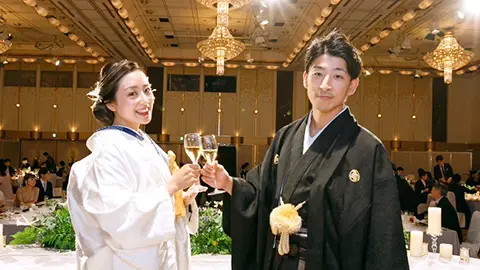VOL.194 JULY 2024
JAPANESE SMALL AND MEDIUM ENTERPRISES LEADING THE WORLD
[POLICY-RELATED NEWS] Report on the Tenth Pacific Islands Leaders Meeting (PALM10)

Group photo at the PALM10
The Pacific Islands Leaders Meeting (PALM) provides a platform for Japan and Pacific Island countries and regions to engage in candid discussions at the leadership level. The summit aims to contribute to regional stability and prosperity while enhancing mutual partnerships. The PALM10 was held in Tokyo from July 16 to 18, 2024. This report highlights the key discussions and outcomes of the meeting.
Pacific Island countries and regions in the three sub-regions of Micronesia, Melanesia, and Polynesia, are important to Japan due to their friendly disposition, as well as our sharing common value and principle, close coordination in various areas and activities at the international arena. PALM was first held in 1997 with the aim of strengthening Japan’s relations with these countries. Since then, it has been hosted in Japan every three years. Pacific Island countries face challenges such as limited and dispersed land, isolation from international markets, small populations and economies, and being surrounded by vast oceans. In addition, they are also vulnerable to environmental changes such as natural disasters and climate change. The PALM meetings address these various issues by seeking solutions together and discussing ways to achieve stability and prosperity in the Pacific Island region at the leadership level.
For the 10th Summit, leaders and other representatives from Japan, 14 Pacific Island countries, two French overseas territories, Australia, and New Zealand—totaling 19 countries and regions (see the map)—gathered, along with the Secretary-General of the Pacific Islands Forum (PIF)*. The previous summit was held online due to the COVID-19 pandemic, making this the first in-person meeting in six years.
At the opening session of the Leaders Meeting held on July 18, the co-chairs, Mr. KISHIDA Fumio, Prime Minister of Japan, and Hon. Mark Brown, Prime Minister of the Cook Islands, the PIF Chair for this year, delivered the opening remarks. Following this, discussions were organized into three sessions and a Working Lunch, focusing on the seven areas outlined in the PIF’s “2050 Strategy for Blue Pacific Continent**.” At the conclusion of the sessions, the leaders adopted the “10th Pacific Islands Leaders Meeting (PALM10) Japan-Pacific Islands Forum Leaders’ Declaration” and the accompanying “PALM10 Joint Action Plan” as the outcomes of the discussions***.

PALM10 Countries and Regions (①② chair countries)
Prepared based on material from the Ministry of Foreign Affairs
History of PALM

Since the 1960s, numerous independent nations have emerged in the Pacific Island region. Japan had already established close relationships with these countries, including through people-to-people exchanges, even before their independence. For Japan today, Pacific Island countries are key international partners and important sources , as well as overseas shipping routes of natural resources(such as fisheries and energy). Through the triannual PALM meetings and the Ministerial Interim Meetings held between them, Japan and the Pacific Island countries have deepened their ties, “KIZUNA”.
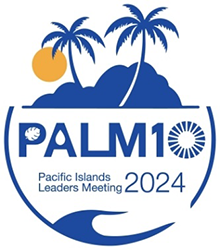
The letters “PALM10” in the logo show elements of leave and water, and the design of the “0” (zero) represents PALM partners, the 19 countries and regions. Also, the upper part of the logo symbolizes the Pacific Islands and the lower part consists of the image of waves which represents the image of a “palm”. Following a selection process from logo design submissions, the design by graphic designer ISHIDA Hironobu was chosen.
PALM10 Meeting Schedule
| July 16 | Welcome reception hosted by Chief Cabinet Secretary HAYASHI Yoshimasa and Mrs. HAYASHI. Bilateral meetings (Japan with Tuvalu, Vanuatu, Niue, and Papua New Guinea). Courtesy call on Prime Minister KISHIDA by the PIF Secretary-General. |
| July 17 | Banquet hosted by Prime Minister KISHIDA Fumio and Mrs. KISHIDA. Bilateral meetings (Japan with Palau, Marshall Islands, Fiji, Samoa, Cook Islands, Tonga, and the Solomon Islands). Courtesy call on Prime Minister KISHIDA by representatives from New Zealand and the Commonwealth of Australia. |
| July 18 | Leaders Meeting (Sessions 1-3, Working Lunch), and joint press conference. Bilateral meetings (Japan with the Federated States of Micronesia and Nauru), and the Partners’ Program. Courtesy call on Prime Minister KISHIDA by the representative from French Polynesia. |
Related events included a luncheon hosted by the Japan-Pacific Island Countries Parliamentary Friendship League, the 3rd meeting of the Pacific Islands Leaders Meeting and Governors (PALM&G), an event co-hosted by the Ministry of Foreign Affairs and Japan International Cooperation Agency (JICA) titled “KIZUNA between Pacific Island Countries (PICs) and Japan through People-to-People Exchange,” and an event co-hosted by the Ministry of Foreign Affairs, Ministry of Economy, Trade and Industry and (Japan External Trade Organization (JETRO) titled “the 4th Japan-Pacific Island Countries Economic Forum”.
The Emperor and Empress hosted afternoon tea at the Imperial Palace, inviting leaders and representatives that attended at the PALM10 on this occasion.
Overview of each session
Session 1: Vision for the PALM Partnership towards 2050, Striding forward Together
Prime Minister KISHIDA noted that Japan successfully implemented robust development cooperation and people-to-people exchanges and human resource development for 7,500 individuals, exceeding the target set under the “Japan’s Pacific Bond (KIZUNA) Policy” announced at PALM9. He emphasized that it is of utmost importance that each of these cooperative efforts serves as a source of strength for Pacific Island countries and regions. The leaders of the Pacific Island countries and regions expressed their appreciation for the pioneering role of PALM, gratitude for Japan delivering its commitments from PALM9, and their willingness to continue further developing cooperation with Japan.
Session 2: “Climate Change and Disasters” and “Ocean and Environment”
Prime Minister KISHIDA stated that Japan and the Pacific Island countries and regions fully share the sense of crisis regarding climate change, described as “the single greatest existential threat” to the region. He announced the “Pacific Climate Resilience Initiative” as an “All Japan” initiative mobilizing Japan’s technology, know-how, and financial resources, which consists of three pillars, (1) strengthening disaster risk reduction and response capacity, (2) promoting decarbonization, and (3) supporting Pacific-led efforts. The leaders of the Pacific Island countries and regions welcomed Japan’s efforts and expressed their willingness to continue cooperation with Japan.
Session 3: “People-Centered Development,” “Resources and Economic Development,” and “Technology and Connectivity”
Prime Minister KISHIDA stated that to protect and strengthen “human dignity,” Japan would continue to promote cooperation in the fields of education and health, and further expand people-to-people exchanges through the current human exchange and human resource development programs between Japan and the region and a recently decided human resource development program for young government officials from Pacific Island countries. The leaders of the Pacific Island countries and regions welcomed Japan’s efforts and expressed their expectations for further cooperation with Japan in finance, trade, investment, and infrastructure development.
Working Lunch Agendas: Cooperation in International Fora, “Peace and Security” and Way Forward from PALM10
Japan and the Pacific Island countries and regions reaffirmed their shared values and principles and concurred on the importance of a free and open international order based on the rule of law. Additionally, Prime Minister KISHIDA expressed Japan’s commitment to promoting robust development cooperation and people-to-people exchanges and human resource development for more than 6,500 people over the next three years. He also proposed holding the Sixth Ministerial Interim Meeting before PALM11.
In conclusion, the leaders reaffirmed their commitment to striding forward together towards realizing a shared vision for the future between Japan and the Pacific Island countries and regions. They also renewed their determination to further strengthen their mutual KIZUNA (bonds). The PALM10 summit was then adjourned.
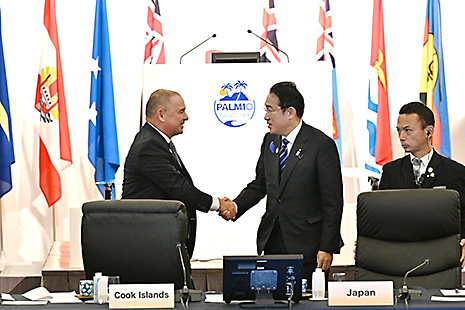
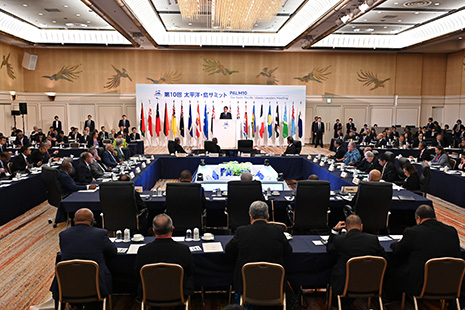
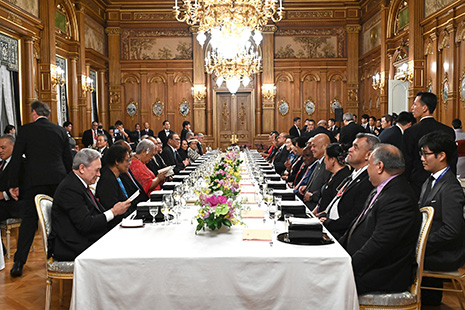
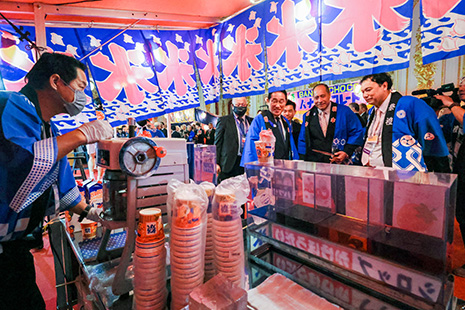
Photos: Courtesy of Cabinet Public Affairs Office
Note: This article has been prepared based on publicly released materials from the Ministry of Foreign Affairs, with their approval.
* The forum is a platform for dialogue among leaders of Oceania countries and aims for regional cooperation. It includes 16 countries and two territories: Cook Islands, Commonwealth of Australia, Federated States of Micronesia, Fiji, French Polynesia, Kiribati, Nauru, New Caledonia, New Zealand, Niue, Palau, Papua New Guinea, Marshall Islands, Samoa, Solomon Islands, Tonga, Tuvalu, and Vanuatu (some country names have been abbreviated.
** In 2022, the Pacific Island countries and regions developed a common strategy for the future, which encompasses seven key areas: (1) Political Leadership and Regionalism, (2) People-Centered Development, (3) Peace and Security, (4) Resources and Economic Development, (5) Climate Change and Disasters, (6) Ocean and Environment, and (7) Technology and Connectivity. This strategy reflects the collective concerns and priorities of the Pacific Island countries and regions.
*** The Leaders’ Declaration and Joint Action Plan can be referenced on the Ministry of Foreign Affairs website.
Photo: Courtesy of Cabinet Public Affairs Office

